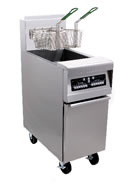Commercial Fryer
In This Guide
Get Rebates,
Incentives & Services
Introduction

Quick service and full service restaurants alike meet a continuous demand for a variety of fried foods. Commercial fryers typically operate from 8 to 12 hours per day, 365 days per year, and cook approximately 100 to 150 pounds a day of food. Given the usage of this equipment, and the fact that typically restaurants have two or more fryers, there is a significant potential for saving energy and money for end users.
There are three types of fryers available in the marketplace: open deep-fat fryers, pressure/kettle fryers, and flat-bottom specialty fryers. Open deep-fat fryers are the most common type of fryer, usually used for french fry cooking, and are the only category covered by ENERGY STAR at this time.
Technology Options
ENERGY STAR qualified fryers offer shorter cook times and higher production rates through advanced burner and heat exchanger designs. All fryers have a similar design and are either gas or electrically fueled. The reservoir contains a sufficient amount of oil that the cooking food is essentially supported by the displacement of oil rather than by the bottom of the vessel. The oil is typically heated by atmospheric or infrared gas burners underneath the kettle or in tubes that pass through the kettle walls. Electric fryers use heating elements immersed in oil.
Key ENERGY STAR Product Criteria:
| Requirements for Open Deep-Fat Fryers | GAS | ELECTRIC |
Energy Efficiency for heavy load (French Fry) Cooking; |
³50% Cooking Efficiency* | ³80% Cooking Efficiency* |
Idle energy rate |
£ 9,000 Btu/hr* |
£ 1,000 watts* |
Key Technology Definitions:
Cooking Energy Efficiency: The quantity of energy input to the food products, expressed as a percentage of the quantity of energy input to the appliance during the heavy-, medium-, and light-load tests. The energy efficiency for fryers varies depending primarily on the design of the applied heating technology. Design improvements include insulation (only for electric fryers; there are safety concerns with insulation and gas fryers) and heat exchanger design (e.g., recirculation tubes).
Idle Energy Rate: The rate of appliance energy consumption while it is maintaining or holding at a stabilized operating condition or temperature. Fryers spend a significant portion of their operation time idling. Even in a busy fast-food restaurant, fryers may be idle 75% of the time.
Product Life: A typical open deep-fat fryer is expected to last 10 years.
Efficiency Benefits
ENERGY STAR qualified fryers offer significant yearly energy savings, while increasing production rates. EPA has estimated that electric and gas fryers that earn the ENERGY STAR can save approximately 1,000 kWh/year and 360 Therms (36 Million Btu)/year in energy. This equates to a savings of approximately $130.00 and $360.00 annually, respectively, on utility bills in California.
Electric Fryers
| Cost-Effectiveness Example | |||
| Conventional Fryer | Energy Star Fryer | Savings | |
| Annual Energy Consumption | 13,072 kWh/year |
12,048 kWh/year | 1,024 kWh/hour |
| Annual Energy Cost | $1,699.00 (CA) $1,307.00 (National) |
$1,566.00 (CA) $1,205.00 (National) |
$133.00 (CA) $102.00 (National) |
| Lifetime Energy Cost (10 Year life) | $16,990.00 (CA) $13,070.00 (National) |
$15,660.00 (CA) $12,050.00 (National) |
$1,330.00 (CA) $1,020.00 (National) |
Gas Fryers
| Cost-Effectiveness Example | |||
| Conventional Fryer | Energy Star Fryer | Savings | |
| Annual Energy Consumption | 1,168 therms |
808 therms | 360 therms |
| Annual Energy Cost | $1,168.00 |
$808.00 |
$360.00 |
| Lifetime Energy Cost (10 Year life) | $1,1680.00 |
$8,080.00 |
$3,600.00 |
Manufacturers
A current list of ENERGY STAR qualified fryer manufacturers can be found on ENERGY STAR’s web site.
The Food Service Technology Center also has information on manufacturers of fryers and other equipment.
Purchasing Tips
|
||
Emerging Technology
Future improvements to increase the performance of fryers may consist of higher part load efficiencies, enhanced temperature control, pulse combustion techniques, modulating burners, recirculation tubes and other technologies. Because of their relatively low operating efficiency, today’s gas fryers offer the best opportunity for improved energy performance.









